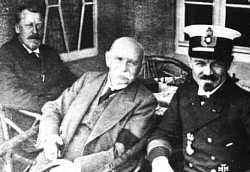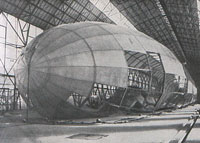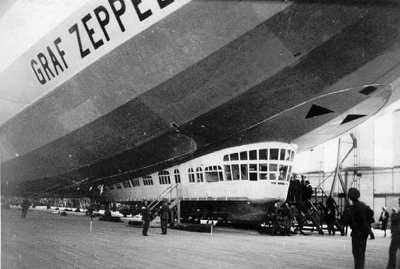The History of the Zeppelin
Part Two: 1917 to 1929

Dr. Hugo Eckener, Graf von Zeppelin, Pieter Strasser
|
Graf von Zeppelin died on 8 March 1917. Pieter Strasser, Chief of the Naval Airship Division and the driving force behind the German airship program, was aboard LZ-112 when she was shot down over the English Channel on 5 August 1918. Dr. Hugo Eckener would go on to lead Zeppelin.
|
|
The German defeat in the war marked the end of German military dirigibles, as the victorious Allies demanded a complete disarmament of German air forces and delivery of the remaining airships as war reparations. Specifically, the Treaty of Versailles contained the following articles dealing with dirigibles:
Article 198.
The armed forces of Germany must not include any military or naval air forces. [...] No dirigible shall be kept.
Article 202.
On the coming into force of the present Treaty, all military and naval aeronautical material [...] must be delivered to the Governments of the Principal Allied and Associated Powers. [...] In particular, this material will include all items under the following heads which are or have been in use or were designed for warlike purposes: [...]
- Dirigibles able to take the air, being manufactured, repaired or assembled.
- Plant for the manufacture of hydrogen.
- Dirigible sheds and shelters of every kind for aircraft.
Pending their delivery, dirigibles will, at the expense of Germany, be maintained inflated with hydrogen; the plant for the manufacture of hydrogen, as well as the sheds for dirigibles may at the discretion of the said Powers, be left to Germany until the time when the dirigibles are handed over. [...]
|

|
On 23 June 1919, a week before the treaty was to be signed, seven Zeppelin crews destroyed their airships in their halls in order to avoid delivery. The remaining dirigibles were transferred to France, Italy, England, and Belgium in 1920.
|
|
Zeppelin and the airline DELAG hoped to resume civilian flights quickly. In fact, despite considerable difficulties, they accomplished two small Zeppelin constructions: LZ-120 Bodensee which first flew in August 1919 and in the following two years transported some 4,000 passengers; and LZ-121 Nordstern, which was planned to fly a regular route to Stockholm.
Unfortunately, in 1921, the Allied Powers demanded these two Zeppelins be handed over as war reparations - compensation for the dirigibles destroyed 1919. Further Zeppelin projects could not be realized, partly because of Allied interdiction. This temporarily halted German Zeppelin aviation.
Dr. Eckener and his coworkers refused to give up and kept looking for investors and a way to circumvent Allied restrictions. Their opportunity came in 1924. The United States had started to experiment with rigid airships, constructing USS Shenandoah and ordering another airship from England. Dr. Eckener saw his chance when the British R38, foreseen to become ZR-2, broke apart and exploded during a test flight above the Humber on 23 August 1921, killing 44 crewmen.
|
|
Under these circumstances, Eckener acquired an order for the next American dirigible. Of course, Germany had to pay the costs for this airship itself, as they were calculated against the war reparation accounts, but for the Zeppelin company this was secondary. So engineer Dr DŸrr designed LZ-126, and using all the expertise accumulated over the years, the company finally achieved its best Zeppelin so far, which took off for a first test flight on 27 August 1924.
| 
LZ-126 USS Los Angeles
|
|
No insurance company was willing to issue a policy for the delivery to Lakehurst, which, of course, involved a transatlantic flight. Dr. Eckener, however, was so confident of the new ship that he was ready to risk the entire business capital. On 12 October, the Zeppelin took off for the States under his command. The ship completed her 8,050 km voyage in 81 hours and two minutes. American crowds enthusiastically celebrated the arrival, and President Calvin Coolidge invited Dr. Eckener and his crew to the White House, calling the new Zeppelin an "angel of peace".
With the delivery of LZ-126 the Zeppelin company had reasserted its lead in rigid airship construction, but it was not yet quite back in business. Acquiring the necessary funds for the next project proved to be hard work in the difficult economic situation of post-war Germany, and it took two years of lobbying and publicity work to secure the realization of LZ-127.
Another two years later, on 18 September 1928, the new dirigible, which was christened Graf Zeppelin flew for the first time. With a total length of 236.6 meters, it was the largest dirigible so far.

Dr. Eckener's initial concept consisted of using LZ-127 Graf Zeppelin for experimental and demonstration purposes to prepare the way for regular airship traveling, but to carry passengers and mail to cover the costs. In October of 1928 the first long-range voyage led the craft to Lakehurst, where Eckener and his crew were once more welcomed enthusiastically with confetti parades in New York and another invitation to the White House. Later Graf Zeppelin toured in Germany and visited Italy, Palestine and Spain. A second trip to the States was aborted in France due to engine failure in May 1929.
|
Copyright ©2007 Puget Sound Airship Society
|
 |
|
